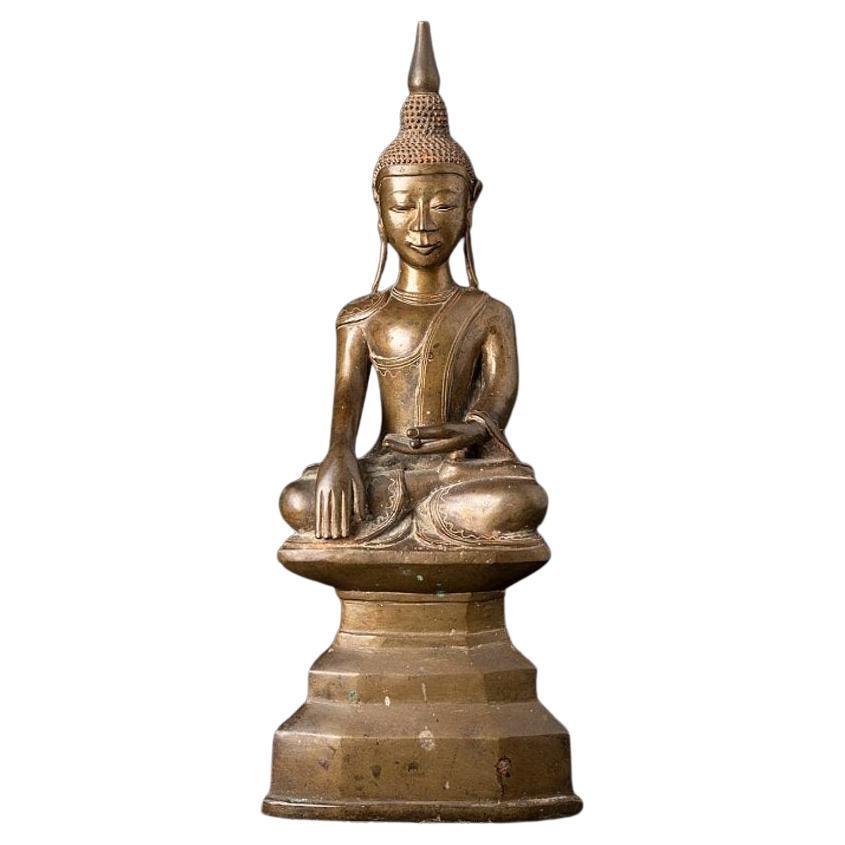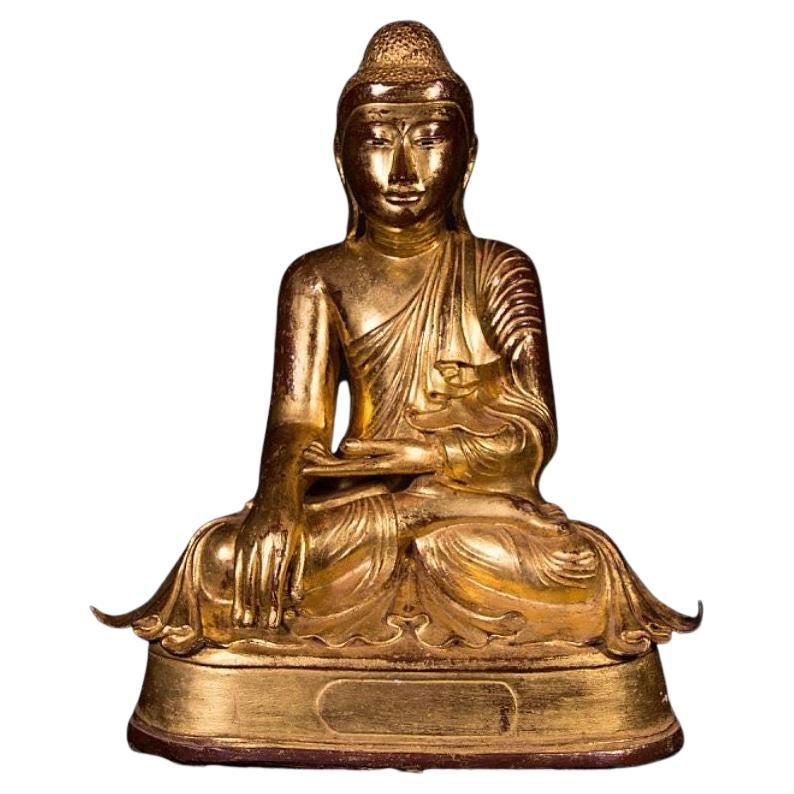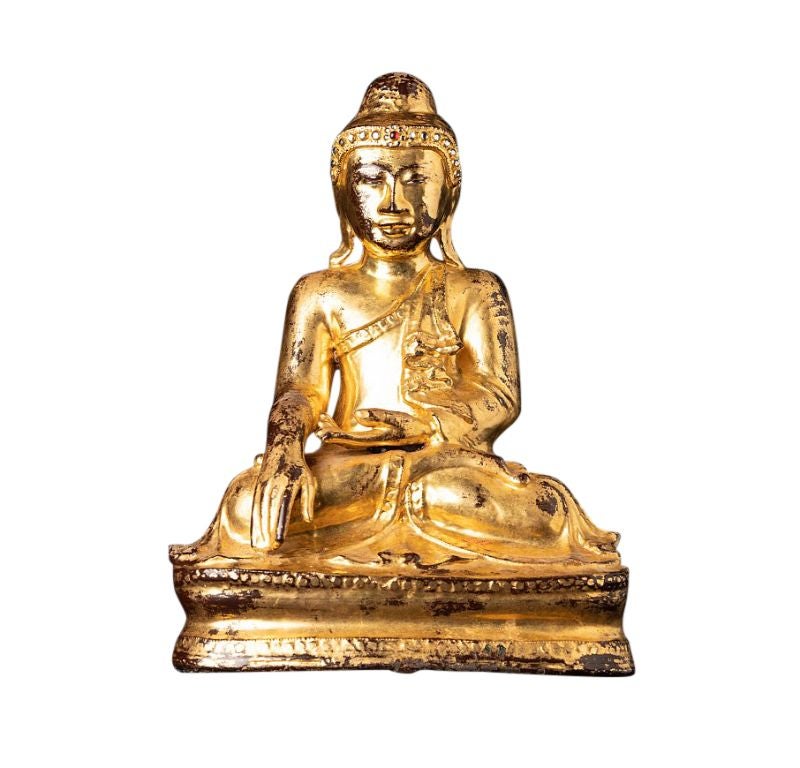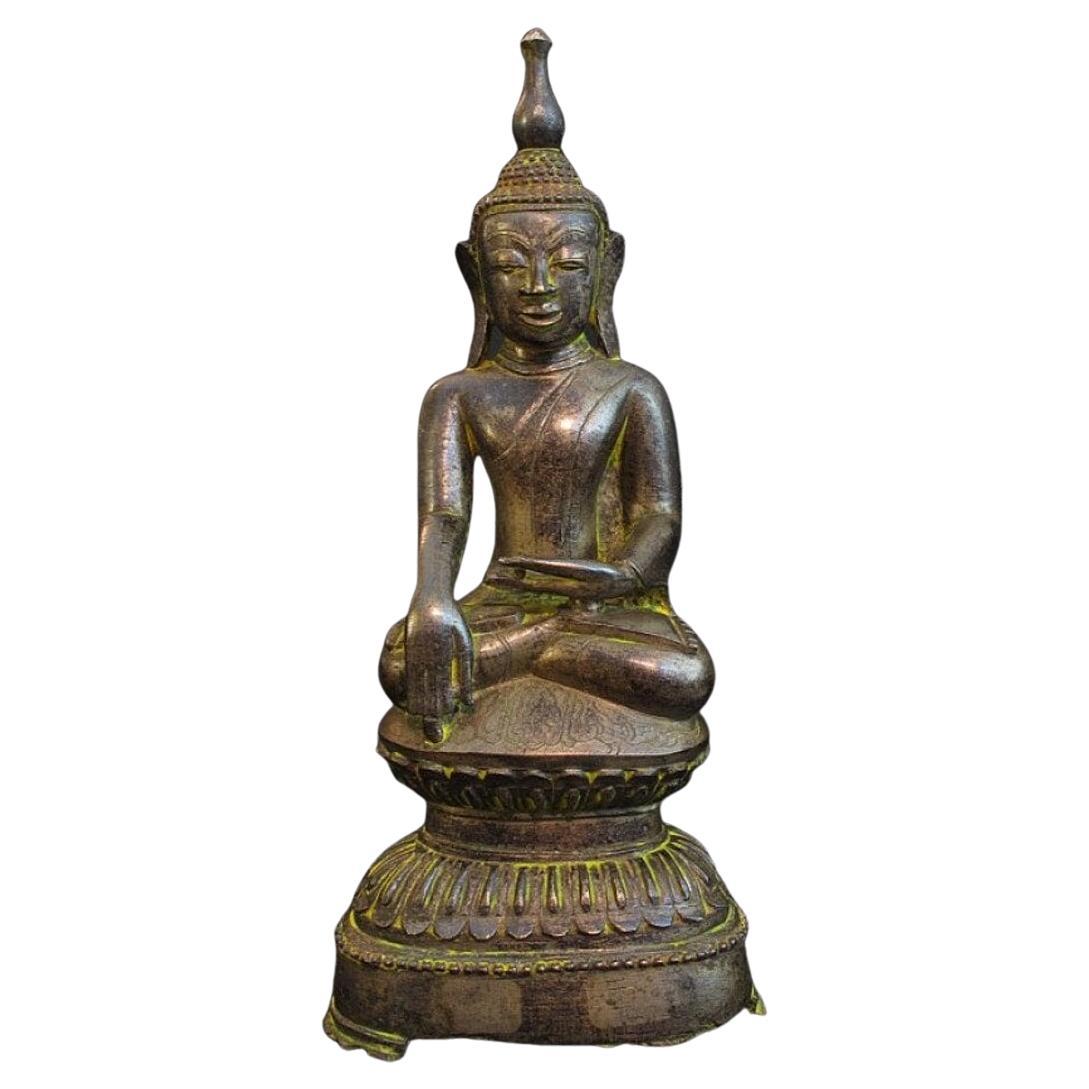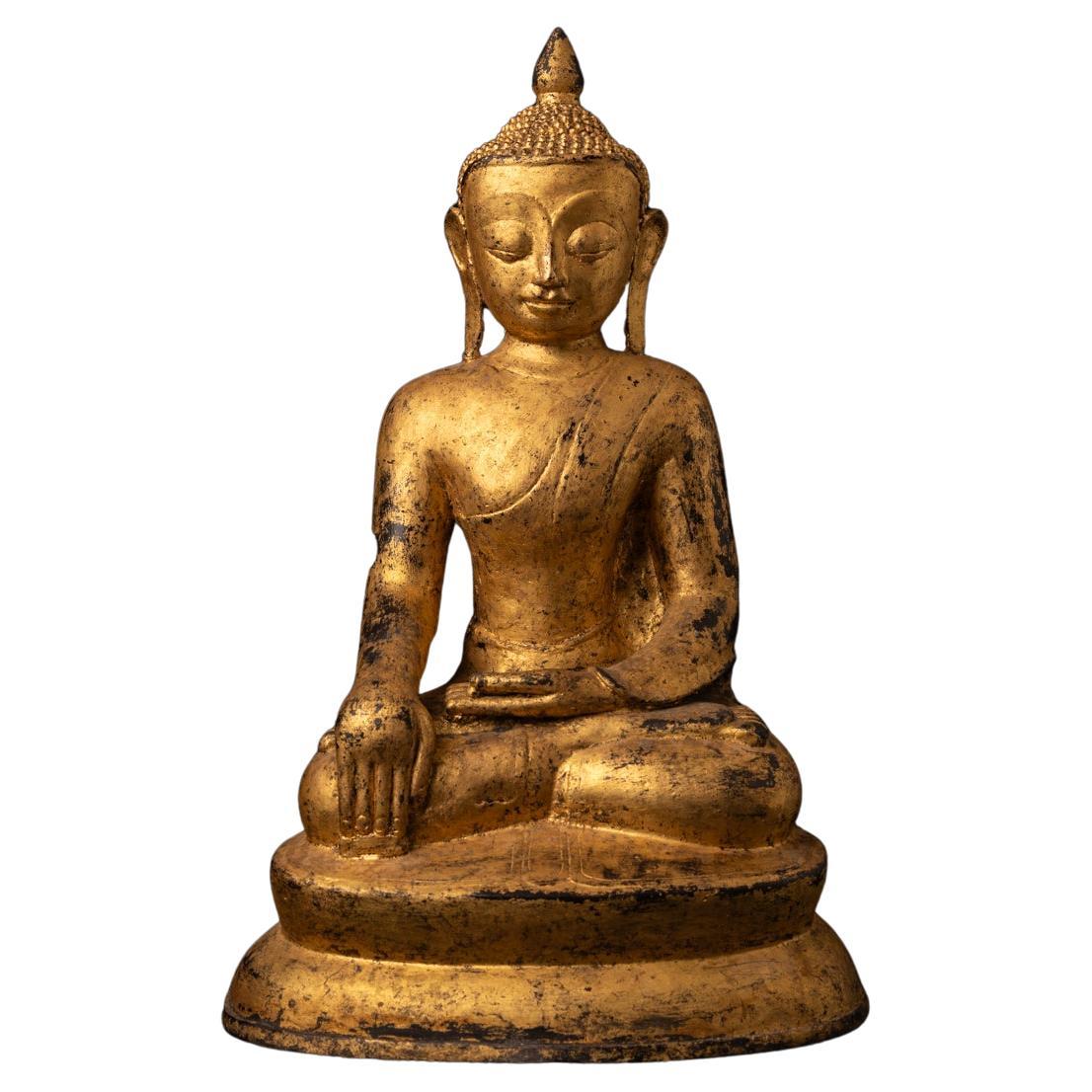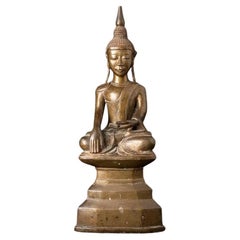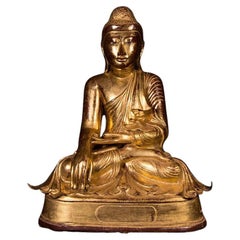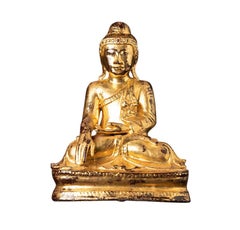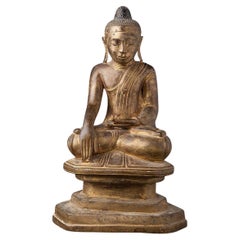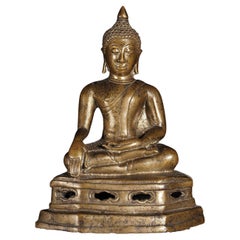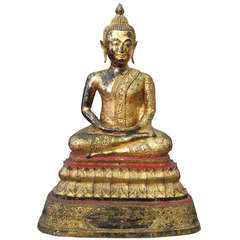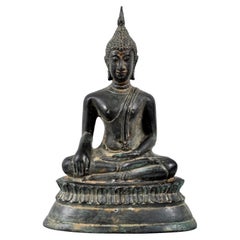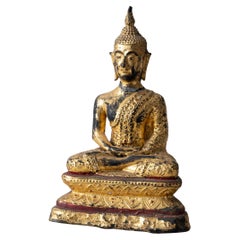Items Similar to Authentic 18th Century Antique Bronze Buddha Statue from Burma: Original Buddhas
Video Loading
Want more images or videos?
Request additional images or videos from the seller
1 of 12
Authentic 18th Century Antique Bronze Buddha Statue from Burma: Original Buddhas
$2,237.93
£1,654.33
€1,869
CA$3,043.75
A$3,410.50
CHF 1,775.30
MX$41,722.22
NOK 22,534.09
SEK 21,283.18
DKK 14,231.52
Shipping
Retrieving quote...The 1stDibs Promise:
Authenticity Guarantee,
Money-Back Guarantee,
24-Hour Cancellation
About the Item
This statue is a bronze sculpture measuring 26.5 centimeters in height, 12.5 centimeters in width, and 8 centimeters in depth. It is believed to have originated from Burma and is estimated to have been created in the 18th century. The statue is in the Ava style and depicts the Bhumisparsha mudra. The statue has been re-gilded with 24 karat gold during the 19th or 20th century. It weighs 1.65 kilograms. The Bhumisparsha mudra is a symbolic hand gesture that represents the moment of enlightenment when the historical Buddha, also known as Siddhartha Gautama, touched the earth with his right hand to call forth the earth goddess to witness his enlightenment. This mudra is often depicted in sculptures of the Buddha, and is considered a very powerful symbol of spiritual awakening and the triumph of the human spirit over suffering.
Statue Details:
Material: bronze.
Measures: 26, 5 cm high.
12,5 cm wide and 8 cm deep.
Weight: 1.65 kgs.
In the 19/20th century re-gilded with 24 krt. gold.
Ava style.
Bhumisparsha mudra.
Originating from Burma.
18th Century.
- Dimensions:Height: 10.44 in (26.5 cm)Width: 4.93 in (12.5 cm)Depth: 3.15 in (8 cm)
- Materials and Techniques:
- Period:
- Date of Manufacture:18th Century
- Condition:Wear consistent with age and use.
- Seller Location:DEVENTER, NL
- Reference Number:Seller: 3095-31stDibs: LU7845232777482
About the Seller
5.0
Vetted Professional Seller
Every seller passes strict standards for authenticity and reliability
Established in 1997
1stDibs seller since 2022
56 sales on 1stDibs
Typical response time: 4 hours
- ShippingRetrieving quote...Shipping from: DEVENTER, Netherlands
- Return Policy
Authenticity Guarantee
In the unlikely event there’s an issue with an item’s authenticity, contact us within 1 year for a full refund. DetailsMoney-Back Guarantee
If your item is not as described, is damaged in transit, or does not arrive, contact us within 7 days for a full refund. Details24-Hour Cancellation
You have a 24-hour grace period in which to reconsider your purchase, with no questions asked.Vetted Professional Sellers
Our world-class sellers must adhere to strict standards for service and quality, maintaining the integrity of our listings.Price-Match Guarantee
If you find that a seller listed the same item for a lower price elsewhere, we’ll match it.Trusted Global Delivery
Our best-in-class carrier network provides specialized shipping options worldwide, including custom delivery.More From This Seller
View AllSpecial Antique Bronze Shan Buddha Statue from Burma
Located in DEVENTER, NL
Material: bronze
43,5 cm high
17,4 cm wide and 11,8 cm deep
Weight: 6.644 kgs
Shan (Tai Yai) style
Bhumisparsha mudra
Originating from Burma
18th century
With inscriptions on the backside of the base, probably the name of the donor of the Buddha
A very special Buddha...
Category
Antique 18th Century Burmese Sculptures and Carvings
Materials
Bronze
Antique Bronze Mandalay Buddha Statue from Burma
Located in DEVENTER, NL
Material: bronze.
Measures: 47 cm high.
38 cm wide and 25 cm deep.
Weight: 26.25 kgs.
Gilded with 24 krt. gold.
Mandalay style.
Bhumisparsha mudra.
Originating from Burma.
1...
Category
Antique 19th Century Burmese Sculptures and Carvings
Materials
Bronze
Antique Bronze Mandalay Buddha Statue from Burma
Located in DEVENTER, NL
Material: bronze
39,5 cm high
28,5 cm wide and 18,6 cm deep
Weight: 8.2 kgs
Gilded with 24 krt. gold
Mandalay style
Bhumisparsha mudra
Originating from Burma
19th century
W...
Category
Antique 19th Century Burmese Sculptures and Carvings
Materials
Bronze
Antique bronze Burmese Buddha statue from Burma Original Buddhas
Located in DEVENTER, NL
This antique bronze Buddha statue is a truly unique and special collectible piece. Standing at 34 cm high, 21.5 cm wide, and 15 cm deep, it is made of bronze, an...
Category
Antique Early 19th Century Burmese Sculptures and Carvings
Materials
Bronze
Antique Bronze Buddha from Burma Original Buddhas
Located in DEVENTER, NL
This antique bronze Buddha statue is a truly unique and special collectible piece. Standing at 24 cm high and weighing 0.661 kgs, it is made of b...
Category
Antique 18th Century Burmese Sculptures and Carvings
Materials
Bronze
18th century Special antique bronze Burmese Buddha from Burma
Located in DEVENTER, NL
This 18th century Special antique bronze Burmese Buddha is a truly unique and special collectible piece. Standing at 58 cm high, 36 cm wide, and 24.8 cm deep, it is made of bronze an...
Category
Antique 18th Century Burmese Sculptures and Carvings
Materials
Bronze
You May Also Like
Superb 15/16th C Northern Thai Bronze Buddha, 8491
Located in Ukiah, CA
Superb 15/16thC Northern Thai bronze Buddha on custom base. This piece measures 5.5" tall and 6.75" on its custom base. Exquisite face, strong spirit...
Category
Antique 16th Century Thai Antiquities
Materials
Bronze
Antique Late 19th Century Gilded Thai Buddha Bronze Statue
Located in Torino, IT
Antique late 19th century Thai Buddha bronze statue, with a lacquered and gilded surface, heavy and with beautiful details.
Category
Antique Late 19th Century Thai Sculptures
Antique 19th Century Southeast Asian Cast Bronze Buddha Statue Sculpture 1800
Located in Portland, OR
A good antique Early 19th Century Southeast Asian Bronze Buddha statue, Circa 1800.
The Buddha seated upon a triangular shaped base with lotus decoration, the Buddha's hands posed i...
Category
Antique 19th Century Tibetan Tibetan Scholar's Objects
Materials
Bronze
Thai Gilt Bronze Buddha, 19th Century
Located in Savannah, GA
A Thai gilt bronze seated buddha, 19th Century.
4 ½ inches wide by 2 ½ inches deep by 7 inches tall
Category
Antique 19th Century Sculptures and Carvings
Materials
Bronze
Large Gilt Bronze Buddha Young Shakyimuni Statue 31 Lb
Located in Somis, CA
The magnificent 31 lb bronze Buddha statue, crafted in the Ming dynasty style, captivates with its timeless beauty and serene presence. Depicting a young Shakyamuni, the statue exude...
Category
20th Century Chinese Ming Sculptures and Carvings
Materials
Bronze
$2,550 Sale Price
28% Off
Early 20th Century Antique Tibetan Carved Bronze Buddha Statuary
Located in Pomona, CA
Look at this magnificent Tibetan Antique Bronze Buddha Statuary. It was hand made from Tibetan Bronze bronze and shows the Buddha seat on a lotus seat with very detailed hand carving...
Category
Early 20th Century Chinese Chinese Export Scholar's Objects
Materials
Bronze
More Ways To Browse
Bronze Measure
Bronze Sculpture 18th Century
18th Century Buddha
Asian Goddess
20th Century Bronze Buddha
Bronze Buddha Hands
19th Century Bronze Buddha
19th Century Bronze Goddess Sculpture
Gilded Bronze Buddha
Bronze Buddha 18th Century
Antique Japanese Stone
Chinese Good Luck
Carved Jade Sculpture
Chinese Jade Sculpture
Tall Stone Sculptures
Antique Temple Carving
Antique Seated Buddha
Lifetime Arts And Crafts Furniture
